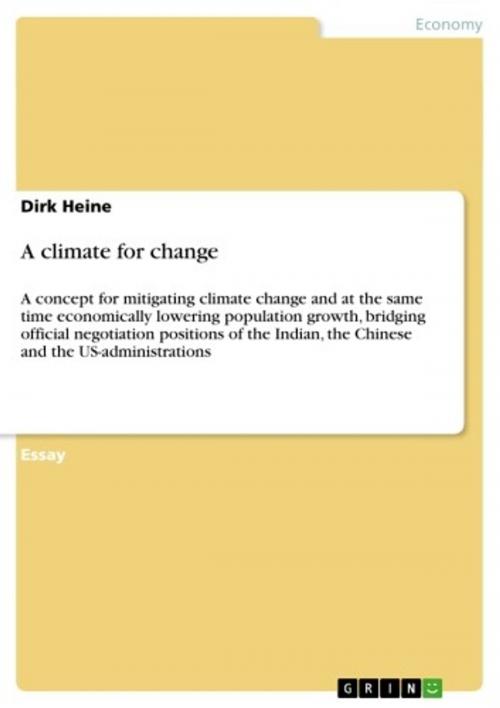A climate for change
A concept for mitigating climate change and at the same time economically lowering population growth, bridging official negotiation positions of the Indian, the Chinese and the US-administrations
Nonfiction, Social & Cultural Studies, Political Science, Politics, Economic Policy| Author: | Dirk Heine | ISBN: | 9783638695350 |
| Publisher: | GRIN Publishing | Publication: | April 29, 2007 |
| Imprint: | GRIN Publishing | Language: | English |
| Author: | Dirk Heine |
| ISBN: | 9783638695350 |
| Publisher: | GRIN Publishing |
| Publication: | April 29, 2007 |
| Imprint: | GRIN Publishing |
| Language: | English |
Essay from the year 2007 in the subject Business economics - Economic Policy, , course: Harvard College China-India Development and Relations Symposium, New York 03-04/2007, 0 entries in the bibliography, language: English, abstract: One of the major vindications for the US not signing Kyoto is that the treaty does not contain any legally binding emission reduction targets for China and India, although these countries have become respectively the second and fifth biggest emitter of CO2. India and China -in return- claim that a path of development that would not harm the climate is too expensive for them; the West has to pay for a historical responsibility that stems from its past emissions, which brought about anthropogenic climate change in the first place. In this way the blame is passed from one nation to the other, and in the meantime all three countries keep on increasing their gross emissions. The essay identifies that part of the problem is the current perspective in intergovernmental emission reduction negotiation. All negotiation is about how much the global top-polluters agree to reduce their emissions. Kyoto left open to what value of CO2-equivalent countries ultimately have to reduce their emissions. Thus it was also not possible to tell how much India and China can increase their emissions. The essay rationalises how the exclusiveness of a top-down negotiation increases the cost of climate change mitigation in the US, as in China and India, by constricting the US-suggestion of international CO2-emission trading to the inflexible Clean Development Mechanism. It describes how China and India could be integrated into emissions trading by setting a definite limit to each country's emissions of CO2-equivalent. Here John Rawl's Original Position is used to identify that this value should be found on a per-capita basis. The essay follows on to analyse the effect that the introduction of such a huge new market would have on the Sino-Indian region compared to the West, and additionally how it could alter the economic relationships between China and India. The essay then presents two ideas on how the cost of this trading scheme would be divided between economically more developed countries and less economically developed countries, in order to improve the political feasibility of the concept. Finally, the essay explains how linking each nation's gross amount of emission permits to the population size at a base year could give a strong economic incentive towards all countries world-wide to lower their populations.
Essay from the year 2007 in the subject Business economics - Economic Policy, , course: Harvard College China-India Development and Relations Symposium, New York 03-04/2007, 0 entries in the bibliography, language: English, abstract: One of the major vindications for the US not signing Kyoto is that the treaty does not contain any legally binding emission reduction targets for China and India, although these countries have become respectively the second and fifth biggest emitter of CO2. India and China -in return- claim that a path of development that would not harm the climate is too expensive for them; the West has to pay for a historical responsibility that stems from its past emissions, which brought about anthropogenic climate change in the first place. In this way the blame is passed from one nation to the other, and in the meantime all three countries keep on increasing their gross emissions. The essay identifies that part of the problem is the current perspective in intergovernmental emission reduction negotiation. All negotiation is about how much the global top-polluters agree to reduce their emissions. Kyoto left open to what value of CO2-equivalent countries ultimately have to reduce their emissions. Thus it was also not possible to tell how much India and China can increase their emissions. The essay rationalises how the exclusiveness of a top-down negotiation increases the cost of climate change mitigation in the US, as in China and India, by constricting the US-suggestion of international CO2-emission trading to the inflexible Clean Development Mechanism. It describes how China and India could be integrated into emissions trading by setting a definite limit to each country's emissions of CO2-equivalent. Here John Rawl's Original Position is used to identify that this value should be found on a per-capita basis. The essay follows on to analyse the effect that the introduction of such a huge new market would have on the Sino-Indian region compared to the West, and additionally how it could alter the economic relationships between China and India. The essay then presents two ideas on how the cost of this trading scheme would be divided between economically more developed countries and less economically developed countries, in order to improve the political feasibility of the concept. Finally, the essay explains how linking each nation's gross amount of emission permits to the population size at a base year could give a strong economic incentive towards all countries world-wide to lower their populations.















